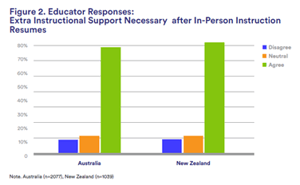Returning to ‘Normal’ School Operations: Key Things to Consider

Preparation For The Return of All Staff And Students
Towards the end of Term One, schools were gearing up to educate their students in a digital learning environment for what seemed, at least at the time, all of Term Two. Closing the physical classroom environments, even though it involved an enormous amount of preparation for online teaching and learning, was actually quite rapid. Closing just before or at the commencement of the April school holidays made this transition less daunting for the students and parents!
With the swift responses of governments across the country and a massive deployment of health staff to prepare for and test forCOVID-19, we have been spared the possible biblical plague proportion of COVID-19 infections and our ‘sombrero’ is quickly diminishing into a flatter curve. As a result, schools are now shifting to a new version of ‘normal’ sooner than was originally generally predicted.
So, what do schools need to do to go back to this ‘new normal’? The ‘new normal’ for Australian society and Australian schools is likely to be some sort of hybrid of what we were used to before COVID-19 struck and some of the adjustments that have been part of the school communities’ lives for the past couple of months such as stricter hygiene practices, social distancing, limited or no co-curricular activities and different ways of learning.
We argue that the return to the ‘new normal’ may well be more difficult than the transition to the digital learning environment and the move to working from home.
In our article earlier this year, "Making a List And Checking It Twice: The COVID-19 Version", we outlined a number of risk control strategies for schools to contemplate in preparation for face-to-face closures and the move to a digital teaching and learning environment. In this article we suggest issues that schools may wish to consider as they return to the ‘new normal’ in the rapidly reducing COVID-19 environment.
What’s Happening Around the Country?
There are varying approaches being deployed by each state or territory government to facilitate a smooth return to the physical face to face teaching and learning environment. These approaches seem to depend on medical advice and the number of ongoing or new COVID-19 cases that are being recorded daily in each jurisdiction.
The Northern Territory took the lead by having a face to face return to school for all students on 20 April and Western Australian government schools had most students returning to class by the commencement of week two of the term. In addition, as was noted in School Governance last week, the Commonwealth Government has ‘encouraged’ non-government schools across the country to open again quickly by offering early access to their July recurrent funding payment if they have students return to their on-campus teaching and learning environment.
Each State or Territory Education Department is now releasing information for government schools regarding this return to the ‘new normal’. The Prime Minister Scott Morrison said it would be the decision of the state and territory leaders when and how the plan is rolled out in each jurisdiction. Following the Prime Minister's announcement, several state and territory leaders were quick to unveil their own roadmaps for easing coronavirus restrictions.
- The Australian Capital Territory
- New South Wales
- The Northern Territory
- Queensland
- South Australia
- Tasmania
- Victoria
- Western Australia
Non-government schools need to decide what is best for their students in their own circumstances. Some may have had no choice regarding the date of full time student and staff return (e.g. due to a government mandate) while others have adopted staggered starts or have retained their digital learning environments or a combination of both until they feel that the risks for their communities have become more manageable.
Suggestions of Risk Controls
In our "Making a List And Checking It Twice- The COVID-19 Version" article, we outlined a number of risk control strategies for schools to contemplate in preparation for the move to a digital teaching and learning environment. We revisit those headings here and offer some strategies for the ‘new normal’ when staff and students return.
Students
Students will require very clear boundaries regarding social distancing when outside of classroom environments. In addition, schools will need to monitor the students’ mental health, possibly on a daily basis, to ensure that they are coping with the return to mainstream schooling and their usual social interactions with their peers. Schools may also need to decide if they are allowed to or if there may be a need to ‘screen’ students or staff before they enter the school campus or at other agreed times.
From an educational perspective, schools will need to reassess the learning that has taken place in the home environments and what, if any, revision may be required when students return. Pivot Professional Learning (Pivot) recently conducted a teacher survey regarding the impact of COVID-19 on distance teaching. Some of their findings included:
 80 per cent of teachers believed their students would need extra instructional support when they got back to school.
80 per cent of teachers believed their students would need extra instructional support when they got back to school.- teachers’ top concerns were students’ social isolation, a decrease in student wellbeing, and potential learning loss. Notably, they ranked students’ social needs above learning loss.
Boarders
Some states and territories have already commenced re-opening boarding facilities; some never closed down. However, according to Farm Weekly, parents have labelled new restrictions placed on students returning to the Western Australia’s government boarding houses as “cruel and contradictory” as parents will be restricted in relation to access to their children for the rest of term. Schools need to ensure that their social distancing and isolation policies are not only appropriate in relation to health, but that they also meet student and parent family requirements as noted within the article
Nonetheless, with most boarders returning over the next few weeks or months, schools will need to determine if there will be a staggered or full-scale return. They also may need to re-engage staff. Many staff, particularly casual staff or international staff on gap-year programs may have been stood down or they may have returned to their home country. In addition, all facilities, including peripherals such as dining rooms, laundries, medical facilities and so forth will require effective cleaning regimes. All of these matters will need to be clearly communicated to parents to allay their fears and concerns.
Staff
In our "Making a List And Checking It Twice- The COVID-19 Version" article, we identified several protocols in relation to staff if there was to be a closure and online work. These included:
- a working from home policy
- daily check-in form/checklist for all staff.
Now, schools should be implementing:
- a return to work policy tailored to their school- and this includes staff who have been stood down
- a daily check-in form/checklist for all staff – COVID-19 has not gone away
- professional development in areas such as wellbeing and mindfulness.
Questions to consider include: Will there be sufficient room in staff rooms to accommodate government physical distancing guidelines? What will happen if a staff member either comes into contact with a COVID-19 sufferer or catches it themselves? Staff travel arrangements will need to be reviewed. Do they travel in by public transport or their own vehicles? Staff return will need to be managed in line with student return. For example, can staff return be staggered to match a staggered student return?
For schools that stood down staff, care may need to be taken where not all staff will be directed to return at the same time. If this is a relatively straightforward issue of different parts of the school returning at different times there should be no issues, but if there is a phased scaling of activities, such as only half of the maintenance staff is to commence initially, care should be taken in relation to how the staff who return to work first are selected. While this is relatively new ground from an employment law point of view, the discrimination and adverse action provisions under the Fair Work Act are likely to apply. Consultation with affected staff may be a way of reducing the risks of harm to the employment relationship.
From a work, health and safety perspective, Safe Work Australia has a resources pages for employers in relation to education and training. This webpage identifies work, health and safety requirements in each state or territory. There is also a separate section for schools produced by the Commonwealth. In addition, Safe Work notes:
Operators of educational institutions must implement control measures to eliminate or minimise the spread of COVID-19 and ensure the health and safety of their workers and others. This is a requirement under Work Health and Safety laws. However, the extent to which educational institutions are currently open to staff or students varies across states and territories
Schools in each state or territory should log onto the relevant site to ensure that they are following the correct advice for their relevant jurisdiction.
Financial Matters
At the commencement of Term Two, the Premier of Western Australian called on parents of non-government school students to request a reduction in fees from their schools for going against the health advice of senior medical officials in their approach to Term Two teaching. Anecdotal discussions with business managers in several schools highlighted that the number of requests for either fee remission or fee discount increased substantially almost overnight following these comments.
As we have previously noted, even as most children return to school, if parents choose to withdraw their children from the school due to reduced financial circumstances or request fee remission, this could mean losses in fees and per capita grants and would result in significant cash flow losses. Schools must have business continuity plans in place to accommodate for these possible financial losses.
Social Aspects
Thankfully, Australia has suffered fewer than 100 COVID-19 deaths to date and so the risk of a school bereavement has been greatly reduced. However, schools will still need to deal with the fears that children and staff may have regarding social distancing and re-infections. Additionally, schools need to be wary of xenophobic or other types of bullying targeted towards students of Asian origin or students who simply have a cold (and some COVID-19 symptoms).
The Pivot survey noted that schools will need to increase opportunities for relationship building. They reported that current relationships between students and teachers were at risk due to the shift to distance teaching. With the return to face to face teaching, teachers will need to focus on rebuilding their student/teacher relationships. Other matters raised included that teachers reported significant increases in demands on their time under remote learning with one teacher writing: “We are exhausted.” Normally, teachers return to school refreshed after a break. Perhaps this time, schools should consider that no-one has really had a complete break. And finally, many teachers revealed that they felt socially isolated. One wrote: “Not only do we teachers miss the social connection with our students, we miss being with our colleagues and friends… teaching is successful when connection is strong.”
Coming back to school will certainly be the panacea that they seek, but schools will need to develop guidelines for use of all staffrooms and staff work areas regarding numbers of staff and social distancing.
General Hygiene and School Cleaning
All staff, students and visitors must practise good hygiene to help reduce the spread of COVID-19. This can be accomplished by encouraging everyone to follow the requirements of the Department of Health and through the provision of hand soap and paper towels in bathrooms, hand sanitiser in classrooms, posters and through modelling and training.
The Department of Health has released a number of pertinent suggestions regarding the frequency and nature of routine cleaning and disinfection in the community here. Schools should:
- clean and disinfect frequently used high-touch surfaces such as benchtops, desks, doorknobs, taps, and handrails at regular intervals throughout the day with a detergent solution or detergent/disinfectant wipes
- clean and disinfect frequently used objects such as computers, photocopiers and sports equipment with detergent solution or detergent/disinfectant wipes
- in those jurisdictions where students are allowed to have mobile phones, schools should restrict access to mobile phones during the school day. Schools and jurisdictions can have the flexibility to make their own procedures around how to do this
- clean and disinfect any play equipment that has not been closed at the end of each recess and the end of the day.
- increase the amount of fresh air available indoors by opening windows or adjusting air conditioning
- provide bins in every classroom for used tissues, and empty them regularly throughout the day
- clean toilets after each recess and at the end of the day.
Summary
In summary, a full time return to the physical classroom will take more time, and possibly more planning, than the original closures and working/studying from home programs.
A fully integrated and school driven approach to coordinate the return by addressing the various types of risk (and accounting for interdependence of risks), will result in a more efficient process, as well as allowing the school to gain a better view of all of the risks facing the entire school.
Where a school is not addressing the return of all staff and students in a holistic manner, it is possible that its response to any one particular risk may be inadequate and the resulting outcomes may lead to a loss of students, disillusioned and tired staff and reputational damage.
About the Author

Craig D’cruz
Resources you may like
Article
Cyber security and AI in schools: emerging risks and governance imperatives
In an era where artificial intelligence (AI) tools are becoming as commonplace as calculators once...
Read MoreArticle
Under 16 social media 'ban’: an explainer for schools
The Australian Government passed a new law called the Online Safety Amendment (Social Media Minimum...
Read MoreArticle
Risk management essentials for schools
Schools face an increasingly complex landscape of risks every day; from safety hazards on school...
Read More
